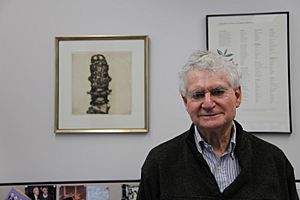Ira Pastan facts for kids
Ira Pastan is a famous American scientist. He was born on June 1, 1931, in Winthrop, Massachusetts. Dr. Pastan works at the National Cancer Institute. This is a big research center in the United States. He is part of important groups like the National Academy of Sciences. In 2009, he won a special award called the International Antonio Feltrinelli Prize for Medicine. His wife, Linda Pastan, was a well-known American poet.
Contents
Dr. Ira Pastan's Early Life and Education
Ira Pastan went to the Boston Public Latin School. He then studied at Tufts College. Later, he attended Tufts Medical School. From 1957 to 1959, he completed his residency. This training happened at the Yale School of Medicine.
Starting His Research Career
Dr. Pastan began his research at the NIH in 1959. He worked with another scientist, Earl Stadtman. In 1970, Dr. Pastan started a new group. It was called the Laboratory of Molecular Biology (LMB). This lab is part of the National Cancer Institute. Today, he is still a co-chief of the LMB. He is working on new treatments for cancer. These treatments are called Immunotoxin Therapies.
Dr. Pastan's Important Discoveries in Science
Dr. Pastan was a pioneer in understanding how cells work. He studied "receptors" on animal cells. Receptors are like special locks on a cell's surface. Only the right "key" (a specific molecule) can open them. He also found a key way genes are controlled in bacteria.
How Genes Are Controlled
With Robert L. Perlman, he found a major way genes are turned on. They showed that cyclic AMP and its receptor protein (CRP) control many genes. This discovery helped explain how hormones work in animal cells. It showed how they affect gene expression.
New Cancer Treatments: Immunotoxins
Dr. Pastan's current work focuses on Recombinant Immunotoxins (RITs). These are new ways to treat cancer. Scientists use special techniques to create these RITs. They combine parts of an antibody with a strong bacterial toxin. The antibody part helps the toxin find cancer cells. It attaches to them, like a guided missile.
Understanding Cell Receptors and Hormones
Dr. Pastan and Jesse Roth showed that animal cells have specific protein receptors. They also studied hyperthyroidism. This is a condition where the thyroid gland is too active. Dr. Pastan found that antibodies from patients caused this. These antibodies activated a part of the thyroid gland. This helped explain the disease.
He also watched how hormones interact with living cells. He saw that hormone-receptor groups moved around. They clustered together before entering cells. This helped explain how growth factors enter cells. It also showed why cells sometimes stop responding to growth factors.
The EGF Receptor and Cancer
After the EGF receptor was found, Dr. Pastan made big steps. He and his team learned a lot about this receptor. They found that the EGF receptor gene was often changed in cancer cells. It was found in many cancers, like skin cancers. They showed that too much EGF receptor could turn normal cells into cancer cells. This proved it was a "proto-oncogene." This means it can lead to cancer. This research helped create new cancer therapies. These therapies use antibodies to target the EGF receptor.
Developing New Immunotoxin Therapies
Dr. Pastan is now creating new cancer treatments. He makes special proteins called recombinant immunotoxins (RITs). These proteins combine parts of antibodies with a bacterial toxin. The antibodies target proteins on cancer cells.
Three of these RITs are being tested in people. They are used for different types of cancer.
- One RIT is called HA22 or Moxetumomab pasudotox (Moxe). It targets a protein called CD22 on certain blood cancers. Moxe has helped many patients with Hairy cell leukemia. This is a type of cancer that resists chemotherapy. Moxe is now in a big study to get approval. It has also helped children with Acute Lymphoblastic Leukemia.
- Another RIT is SS1P. It targets a protein called mesothelin. Dr. Pastan and Mark Willingham discovered mesothelin. It is found on many cancers. These include mesothelioma, ovarian, lung, and pancreatic cancers. SS1P has shown good results in studies. When combined with other medicines, it helped patients with advanced mesothelioma. Tumors shrank and stayed small for a long time. This was a big step for mesothelioma treatment.
Improving Immunotoxin Treatments
Dr. Pastan is working to make immunotoxins even better. A problem with RIT therapy is that the body can make antibodies against the RIT. This stops the treatment from working. Dr. Pastan has found ways to make RITs that the body is less likely to fight. A new RIT is being prepared for studies. It targets cancers with mesothelin. These studies are expected to begin soon.
Awards and Recognition
Dr. Pastan has received many important awards for his work:
- Van Meter Prize, 1971
- G. Burroughs Mider Lectureship, National Institutes of Health, 1973
- Membership, National Academy of Sciences, 1982
- American Academy of Arts and Sciences, 1997
- Fellow, American Academy of Microbiology, 1997
- Fellow, American Association for the Advancement of Science, 1997
- International Feltrinelli Prize for Medicine, 2009
- Nathan Davis Award for Outstanding Government Service from the American Medical Association, 2010
- Membership, Institute of Medicine of the National Academies, 2010
- 2020 Winner - Samuel J. Heyman Service to America Medalist, Paul A. Volcker Career Achievement. [1]


